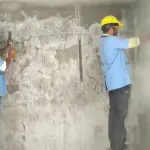If water stains appear on your ceiling, it’s essential that you quickly trace back their source. As soon as you identify its source, professional roof repair teams can begin fixing it more easily.
Begin by inspecting the flashing (thin metal sheeting that surrounds pipes and vents). If there is any sign of broken seal, roofing cement or caulk may help reseal it.
Damaged Shingles
Your roof serves as the primary protection from the elements for your home, yet over time it may become worn and damaged, leading to leaks or other problems requiring repair or even replacement.
Broken shingles are one of the primary indicators that it’s time to call in a professional roofing service to take care of any necessary roofing needs.
Creasing, flipping and tearing are three common types of roof damage which often result in water penetration into a ceiling leak, as these defects often bend up and down along their edges. When these defects form on a shingle roof it can result in water penetration resulting in ceiling leaks.
Damaged shingles can not only leak, but can expose a roof to other potential issues as well. A broken or torn shingle exposes your underlayment – the layer between your shingles and plywood roof deck, which provides underlayment protection; flashing seal joints on your roof; as well as chimney or vents which have degraded and leak.
To repair a shingle, first climb onto your roof and carefully locate any damaged shingles. Use the flat side of a pry bar to carefully lift and remove them while pulling out nails beneath. Next, slide your new shingle into place ensuring its back edge lies beneath shingles on both sides for alignment purposes. You can click the link: https://www.wikihow.life/Fix-Shingles to learn more.

Missing Shingles
One missing shingle may not seem like much, but ignoring it can cause problems down the road. Leaks could develop hours, days or weeks later; left unattended they can lead to rotten sheathing, mold growth and interior damage that leads to even further issues down the line.
No roof can escape Mother Nature’s wrath; even those designed to withstand windstorms may succumb in a tornado or blizzard. But most often missing shingles occur through wear and tear over time. Experts in Tomball roof repair are able to assess storm damage and perform any necessary repairs. Some minor repairs can be performed by homeowners, but they should be carefully undertaken.
Like Us on Facebook!
If you find a missing shingle, set up your ladder in an accessible and safe location before climbing to where the missing one lies. Carefully lift and remove it using a pry bar before installing a replacement one; use nails as necessary and make sure that nails are replaced after each repair process has completed to avoid further damage to the property.
Subscribe Us on YouTube!
Once complete, professional inspection may be recommended to make sure no further harm was caused during repairs.

Damaged Flashing
Flashing is a thin metal strip used to cover seams and edges on roofs, and is particularly crucial near chimneys, vents, skylights, and other roof penetrations. When damaged, this flashing can let water in through seams or edges and cause significant structural damage to homes. You can visit this site to learn more about flashing.
Flashing can become damaged from exposure to the elements, leading to rust spots or corrosion in areas with direct sunlight, where too much sun can break through its protective zinc coating on steel flashing and lead to more frequent sunburns than is healthy for its lifespan.
Furthermore, freeze-thaw cycles during winter leave tiny gaps that expand and contract as the temperature warms up and melts the ice away, potentially leading to leaks when temperatures warm back up enough for its melting off.
Flashing may become bent or dented during a storm, causing more extensive damage that might not seem obvious but which could compromise its integrity, weakening it and possibly breaking its galvanized coating. Furthermore, high winds could easily strip it from your roof should this occur.
Cracked or missing flashing should always be repaired by a professional roofer.
Damaged Vents
Modern homes contain numerous ventilation components on their roofs that enable air and gas to move from inside the house up through its structure and into vents on its exterior, contributing to homeowner health and wellbeing. Storms may cause significant damage to these elements of ventilation.
Roof leaks around vents can allow rainwater to seep into the attic and cause mold and wood rot problems that require professional intervention to correct. This issue should never be taken lightly and must be treated immediately by trained personnel in order to remain structurally sound.
After any major storm, it’s wise to inspect all your roof vents carefully. High winds and flying debris can loosen flashing components and allow water to seep into vulnerable areas of the roof. Check your plumbing vent boots carefully; replace any nails that have pulled free or are missing with rubber-washered screws which will prevent further damage to them as well as provide better moisture resistance in future.




















